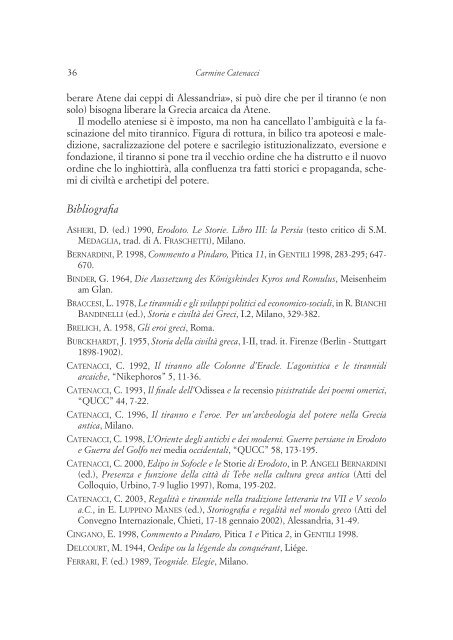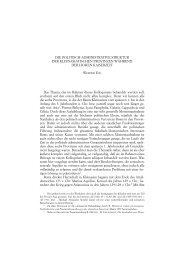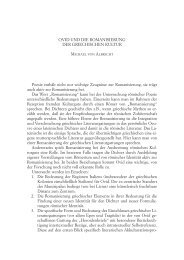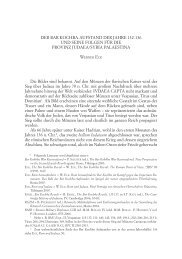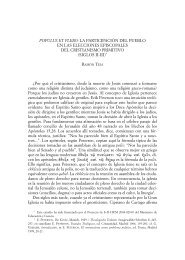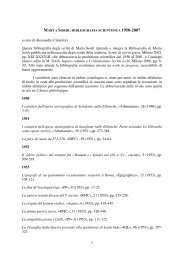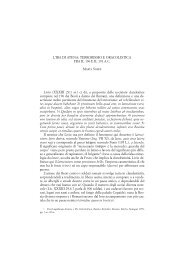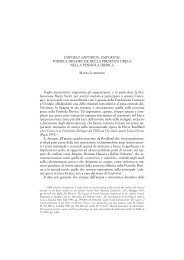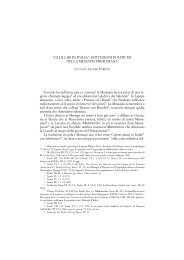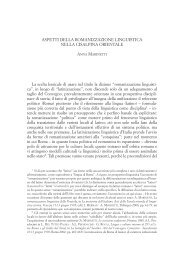1. Il dibattito erodoteo sulle forme di governo - Fondazione Niccolò ...
1. Il dibattito erodoteo sulle forme di governo - Fondazione Niccolò ...
1. Il dibattito erodoteo sulle forme di governo - Fondazione Niccolò ...
You also want an ePaper? Increase the reach of your titles
YUMPU automatically turns print PDFs into web optimized ePapers that Google loves.
36 Carmine Catenacci<br />
berare atene dai ceppi <strong>di</strong> alessandria», si può <strong>di</strong>re che per il tiranno (e non<br />
solo) bisogna liberare la Grecia arcaica da atene.<br />
il modello ateniese si è imposto, ma non ha cancellato l’ambiguità e la fascinazione<br />
del mito tirannico. figura <strong>di</strong> rottura, in bilico tra apoteosi e male<strong>di</strong>zione,<br />
sacralizzazione del potere e sacrilegio istituzionalizzato, eversione e<br />
fondazione, il tiranno si pone tra il vecchio or<strong>di</strong>ne che ha <strong>di</strong>strutto e il nuovo<br />
or<strong>di</strong>ne che lo inghiottirà, alla confluenza tra fatti storici e propaganda, schemi<br />
<strong>di</strong> civiltà e archetipi del potere.<br />
Bibliografia<br />
asheri, D. (ed.) 1990, Erodoto. Le Storie. Libro III: la Persia (testo critico <strong>di</strong> s.M.<br />
meDaGLia, trad. <strong>di</strong> a. FrasChetti), Milano.<br />
BernarDini, P. 1998, Commento a Pindaro, Pitica 11, in GentiLi 1998, 283-295; 647-<br />
670.<br />
BinDer, G. 1964, Die Aussetzung des Königskindes Kyros und Romulus, Meisenheim<br />
am Glan.<br />
BraCCesi, L. 1978, Le tiranni<strong>di</strong> e gli sviluppi politici ed economico-sociali, in r. BianChi<br />
BanDineLLi (ed.), Storia e civiltà dei Greci, i.2, Milano, 329-382.<br />
BreLiCh, a. 1958, Gli eroi greci, roma.<br />
BurCkharDt, J. 1955, Storia della civiltà greca, i-ii, trad. it. firenze (Berlin - stuttgart<br />
1898-1902).<br />
CatenaCCi, c. 1992, <strong>Il</strong> tiranno alle Colonne d’Eracle. L’agonistica e le tiranni<strong>di</strong><br />
arcaiche, “nikephoros” 5, 11-36.<br />
CatenaCCi, C. 1993, <strong>Il</strong> finale dell’o<strong>di</strong>ssea e la recensio pisistratide dei poemi omerici,<br />
“QUcc” 44, 7-22.<br />
CatenaCCi, C. 1996, <strong>Il</strong> tiranno e l’eroe. Per un’archeologia del potere nella Grecia<br />
antica, Milano.<br />
CatenaCCi, C. 1998, L’Oriente degli antichi e dei moderni. Guerre persiane in Erodoto<br />
e Guerra del Golfo nei me<strong>di</strong>a occidentali, “QUcc” 58, 173-195.<br />
CatenaCCi, C. 2000, E<strong>di</strong>po in Sofocle e le storie <strong>di</strong> Erodoto, in P. anGeLi BernarDini<br />
(ed.), Presenza e funzione della città <strong>di</strong> Tebe nella cultura greca antica (atti del<br />
colloquio, Urbino, 7-9 luglio 1997), roma, 195-202.<br />
CatenaCCi, c. 2003, Regalità e tirannide nella tra<strong>di</strong>zione letteraria tra VII e V secolo<br />
a.C., in e. LuPPino manes (ed.), Storiografia e regalità nel mondo greco (atti del<br />
convegno internazionale, chieti, 17-18 gennaio 2002), alessandria, 31-49.<br />
CinGano, e. 1998, Commento a Pindaro, Pitica 1 e Pitica 2, in GentiLi 1998.<br />
DeLCourt, m. 1944, Oe<strong>di</strong>pe ou la légende du conquérant, Liége.<br />
Ferrari, F. (ed.) 1989, Teognide. Elegie, Milano.


